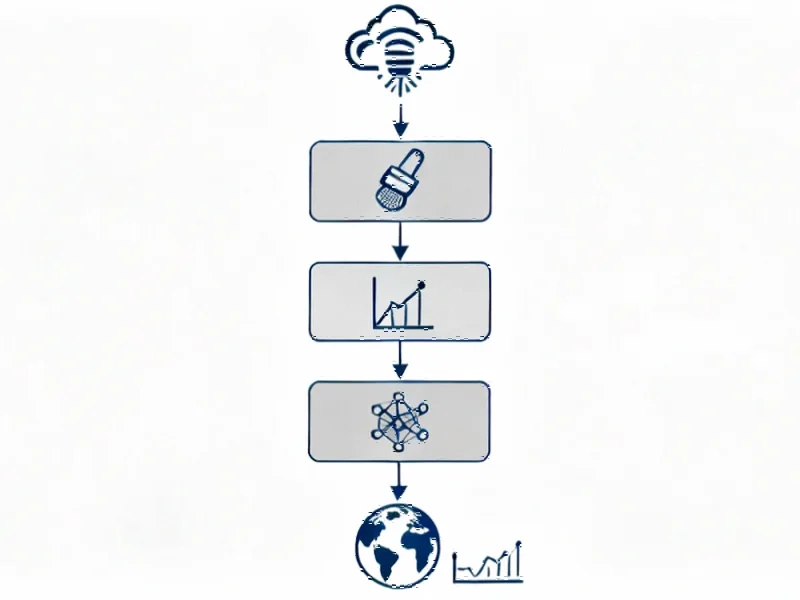Revolutionizing Meteorological Forecasting with Machine Learning
In a groundbreaking development for weather prediction, researchers have successfully combined SHapley Additive exPlanations (SHAP) with fuzzy logic to create a highly efficient rainfall forecasting system. This hybrid approach leverages the LightGBM machine learning framework alongside meteorological expertise to achieve remarkable 82% accuracy in predicting next-day rainfall across diverse Australian climates. The model represents a significant advancement in computational meteorology, offering both superior performance and practical interpretability for operational forecasting.
Comprehensive Data Processing Pipeline
The system processes raw meteorological data through a sophisticated six-stage workflow that transforms basic weather observations into reliable forecasts. Beginning with Raw Daily Data Ingestion from seven Australian weather stations, the pipeline progresses through Missing-Data Imputation, Feature Engineering, Model Standardization, Model Training, and concludes with rigorous Model Evaluation. This structured approach ensures that each processing step builds systematically upon the previous, creating a robust foundation for accurate predictions. The methodology represents significant advancements in predictive automation that could transform how meteorological agencies worldwide approach forecasting.
Feature Engineering and Correlation Insights
The Pearson correlation heatmap analysis reveals crucial relationships between meteorological variables that drive the model’s predictive power. Temperature differentials (ΔT = MaxTemp-MinTemp) and pressure changes (ΔP = Pressure9am-Pressure3pm) emerged as particularly informative engineered features. While minimum and maximum temperatures show strong positive correlation (ρ ≈ +0.85), the subtle differences between them provide critical signals about humidity levels and cloud cover. Similarly, pressure measurements, though strongly correlated throughout the day (ρ ≈ +0.90), reveal important forecasting clues when examined as differentials, with ΔP showing stronger conditional correlation with rainfall during frontal seasons.
The research identified several key negative correlations that significantly impact prediction accuracy. Humidity3pm and Sunshine demonstrate a strong inverse relationship (ρ ≈ -0.72), where afternoons with high humidity typically experience minimal sunshine, indicating dense cloud cover that frequently leads to precipitation. This insight directly informed the fuzzy-logic subsystem, which implements straightforward rules like “High Humidity3pm AND Low Sunshine ⇒ Very High Rain Likelihood.” These developments in analytical methodology parallel industry developments in computational power that enable increasingly sophisticated modeling approaches.
Model Performance and Comparative Advantages
The hybrid LightGBM-Fuzzy system achieves impressive metrics, with 82% accuracy and AUC = 0.8818 for “rain Tomorrow” prediction. This performance substantially outperforms previous approaches, including Li et al.’s (2023) artificial neural network that achieved approximately 75% accuracy with similar Australian data. The current model also demonstrates remarkable computational efficiency, processing samples approximately 2.5 times faster than previous implementations while maintaining higher accuracy.
When compared to Zhang & Wang’s (2024) XGBoost-fuzzy hybrid applied to Chinese monsoon regions (achieving 92-95% accuracy), the current model’s performance on Australia’s more varied climate conditions remains highly competitive. The research team emphasized that their fuzzy rules were grid-search-tuned rather than manually crafted, enhancing generalizability across different climatic regions. These algorithmic improvements reflect broader recent technology trends toward more robust and adaptable computational systems.
Interpretability and Feature Importance
SHAP analysis confirms the model’s alignment with meteorological theory, identifying Sunshine and Humidity3pm as the most influential features (|SHAP| ≈ 0.83, 0.75), followed by Cloud3pm and Pressure3pm (≈ 0.60, 0.45), and WindGustSpeed (≈ 0.40). This feature importance ranking validates the model’s meteorological soundness, as intense sunshine typically suppresses rainfall, while high afternoon humidity and dense clouds drive convective or frontal precipitation. The interpretability afforded by SHAP analysis, combined with the transparent fuzzy-logic rules, provides forecasters with clear insights into the model’s decision-making process.
The research demonstrates how weakly correlated variable pairs in raw form (such as Rainfall vs. Pressure3pm with ρ ≈ -0.10) can become highly predictive through appropriate feature engineering and conditional splits within the LightGBM framework. This approach to extracting meaningful signals from complex data relationships mirrors related innovations in data analysis across multiple domains.
Geographical and Climatic Considerations
The analysis of station-specific rainfall patterns reveals how the model adapts to diverse Australian climates. Cairns, with its tropical monsoon climate, records the highest average daily rainfall at over six millimeters, while desert locations like Woomera and Uluru experience minimal precipitation below 0.5 mm. Intermediate values characterize subtropical coastal cities (Brisbane ~3.0 mm, Sydney ~3.4 mm), Mediterranean climates (Perth ~1.7 mm, Adelaide ~1.6 mm), and temperate southern regions (Melbourne ~2.0 mm).
This geographical variation presented significant challenges for model development, as forecasting rules that apply to Darwin’s monsoon season differ substantially from those relevant to Perth’s dry summers. The hybrid approach successfully navigates these differences by combining LightGBM’s ability to learn location-specific patterns with the fuzzy system’s meteorological reasoning. The security considerations in handling such diverse datasets parallel concerns in market trends regarding data protection across distributed systems.
Future Directions and Applications
The research team identified several promising avenues for further enhancement, including expanding station coverage to capture additional microclimates, integrating hourly data for near-term predictions, and incorporating supplementary data sources such as soil moisture measurements, satellite-derived cloud-top temperatures, and large-scale climate indices (MJO, ENSO). Seasonal adaptation of fuzzy membership functions could better capture shifting climatological baselines, potentially increasing daily “rain Tomorrow” accuracy beyond 85%.
The model’s combination of high accuracy (82%), computational efficiency (≈0.0077 s/sample inference), and interpretability positions it well for operational deployment. The approach demonstrates how hybrid AI systems can bridge the gap between purely data-driven machine learning and knowledge-based expert systems in meteorology. The successful implementation of such specialized computational systems reflects the growing sophistication in industry developments across multiple technology sectors.
Broader Implications for Weather Forecasting
This research represents a significant step toward more reliable, efficient, and interpretable weather prediction systems. By successfully integrating advanced machine learning with meteorological domain knowledge, the hybrid approach addresses critical limitations of purely data-driven methods while avoiding the rigidity of traditional rule-based systems. The methodology’s strong performance across Australia’s diverse climatic regions suggests potential applicability to other geographically varied areas worldwide.
As climate patterns become increasingly volatile, such advanced forecasting systems will play a crucial role in agricultural planning, water resource management, disaster preparedness, and daily activity planning. The research demonstrates that the future of meteorological forecasting lies not in choosing between data-driven and knowledge-based approaches, but in creatively combining their respective strengths to achieve superior results.
This article aggregates information from publicly available sources. All trademarks and copyrights belong to their respective owners.
Note: Featured image is for illustrative purposes only and does not represent any specific product, service, or entity mentioned in this article.



